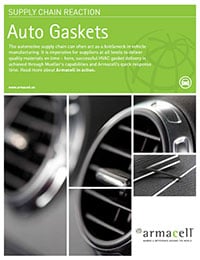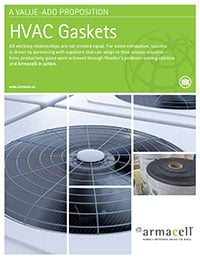
To solve a problem, sometimes you have to work with what you have because you don’t know another solution exists.
But what if it did?
Mueller Custom Cut provides services for virtually any industry. We can do this because we have access to a wide range of materials and engage with a diverse clientele base.
Here’s how we introduced some innovative uses for crushed foam to our HVAC and automotive customers.
What Is Crushed Foam?
In the foam-manufacturing process, chemicals are combined, then heat is introduced, which causes a thermal reaction. The compound expands, then closed cells fill up with gas or air. They don’t rupture or connect with other cells.
There’s a secondary level of closed cell foam called semi-closed cell foam or crushed foam. It’s created when closed cell foam is crushed just enough to rupture a small number of cells.
How Did Mueller Help HVAC Find a Use for Crushed Foam?
A company was using non-crushed foam to fill in the gaps around the doors of HVAC units. However, in these cases, the gaps are not all the same size. That means non-crushed foam might work okay in one area, but not do well in others because of tolerance invariability.
“If you use a firmer foam that is not crushed or not that soft, for it to fill into the thicker gap areas, it would be compressed too much at the hinges, so you couldn’t shut the door,” said Mike Bryant, sales manager.
Likewise, if you were using non-crushed foam that fit well near the hinges, it wouldn’t be thick enough to adequately fill the bigger gaps. This would result in leaks.
The company tried using pieces of non-crushed foam in multiple thicknesses to compensate for the change in gap size. But there were still leakage points at the places where the two different sizes would meet.
Plus, it was more work.
Mueller suggested the HVAC company use crushed foam instead because it’s more conformable. This material can compress to the size needed to seal in smaller gaps but still stay thick enough to fill the larger gaps. There’s no problem with the crushed foam being too thick or too thin because it adapts to the application.
How Did Mueller Help Automotive Discover Crushed Foam?
In the automotive industry, manufacturers have started replacing metal stamped parts with plastic to lighten the load of vehicles and meet fuel efficiency standards. However, when workers try to screw connectors into these new parts, and they’re using non-crushed foam, the plastic will bend because it’s not as rigid as the metal.
Mueller advised one of these businesses to use crushed foam with plastic parts instead of non-crushed foam because it’s more conformable. This means workers don’t have to put as much pressure on the plastic to make a good seal. The part stays in place, and the structure stays intact.
“They needed a foam that was much more conformable to keep the plastic from flexing or bowing in different applications,” Bryant said.
Why Did Mueller Suggest This Material to Different Industries?
That’s the advantage of working with Mueller: innovation.
When we find a material that’s successful in one industry, we share that knowledge with our other customers. And because we work with a range of materials and a variety of clients, we’re always coming up with alternative solutions to suit a customer’s needs. If we only worked with one industry, our creativity would be stifled, and our clients would get fewer opportunities to enhance their applications.
Mueller customers can also get a deal on pricing when it comes to using the same material as other industries. When we work with a material often, we can usually get a larger buy-in volume, which means we can pass along that savings to our customers.
Our objective is to deliver custom cutting to our customers to help them meet their manufacturing needs, and we choose quality materials to achieve that goal.

The Benefits of Using Crushed Foam in HVAC & Automotive
Now you know how Mueller showed our HVAC and automotive customers the benefits of crushed foam.
This alternate material allows workers in the HVAC industry to fill in gaps around units without having to use pieces of varying thickness or worrying about leakage points. Crushed foam also works well with plastic parts in the automotive industry because it keeps them from bending when sealed.
Mueller has a large collection of materials for your business to pick from to make your current application better or turn your blueprint into a reality. Contact us today to discuss your needs!




